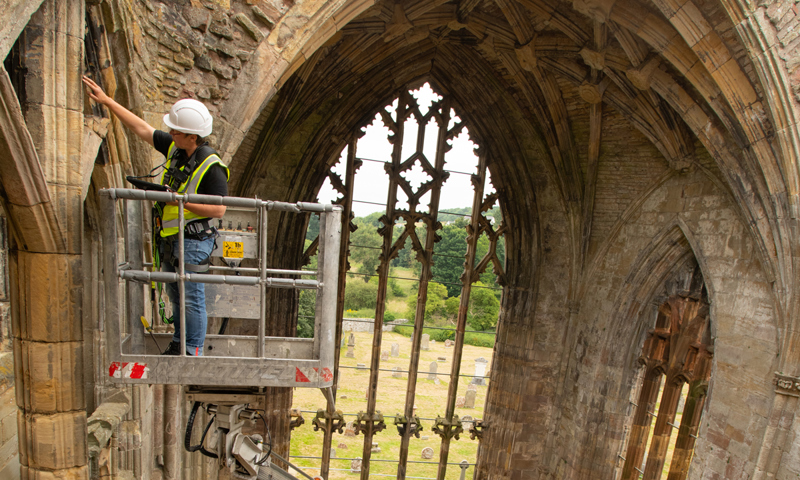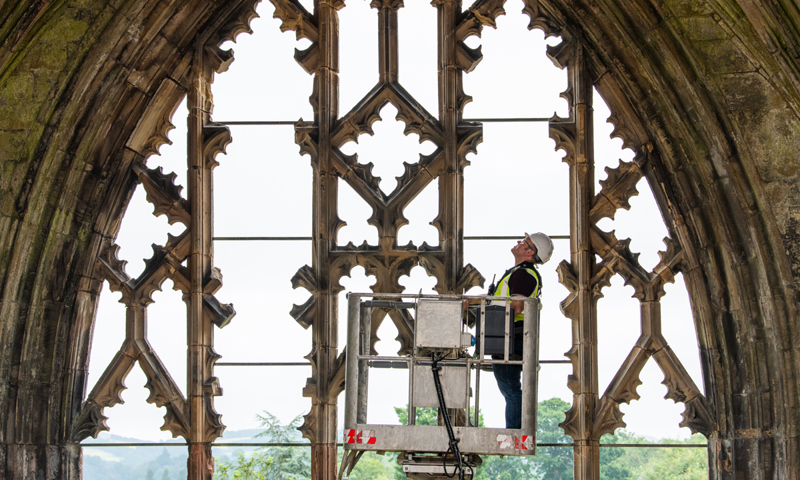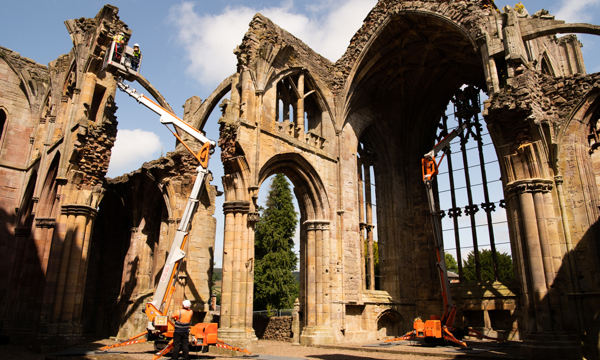Historic Environment Scotland (HES) is implementing a new approach to the inspection of historic properties in response to the effects of climate change. A programme of tactile condition surveys on over 200 properties will assess the extent of deterioration of high-level masonry and ensure public safety against the risk of potentially unstable building fabric. It will mean that access to some properties will be restricted to enable surveys to be conducted.
Scotland’s public heritage body, which cares for 336 historic buildings and sites across Scotland, believes the programme is a proactive step towards transforming the way the nation’s most precious places are protected, repaired and experienced in the face of accelerating decay from climate change.
The tactile survey programme, which is the result of ongoing risk assessment and sample surveys, will assess the impact of climate change, as well as the scale of deterioration caused by a number of other factors, including the materials used in the building’s construction, its age and physical location. It is anticipated remedial works could require significant investment over multiple years and, in some instances, require a different management approach to be taken than before.

To ensure public safety, and in response to concerns relating to the risk of failing historic building fabric, HES had embarked on a national project to assess risks to visitors and staff across the properties in care in 2019. Post-lockdown, work was restarted and surveys conducted in spring 2021 identified potentially dangerous fabric at high level, leading to immediate access restrictions at 20 properties for inspection to ensure visitors and staff were not exposed to any possible risks.
The sample surveys conducted on these properties confirmed to conservation specialists at HES that the type of deterioration being seen could only be assessed properly by hands-on, tactile surveys and that the traditional ways of inspecting at high level, such as visual inspection from the ground or by drone, while useful, are not as accurate as a hands-on inspection.
These surveys will inform a programme of repairs, conservation work, adaptation measures, interventions and new ways of caring for these historic assets. Access restrictions were put in place at a further 11 sites in November 2021, with an additional 39 sites following in January 2022 as a precautionary measure because HES assessments showed that the issues found at the initial sites could potentially pose a risk to properties with shared characteristics.
Dr David Mitchell, director of conservation at HES, said:
“The safety of staff, visitors and contractors is our priority and access restrictions at some sites will unfortunately be necessary.
“Our routine inspections are increasingly revealing the deterioration of building fabric at high level. While our changing climate is not the sole reason for deterioration, it has certainly accelerated it and brought the issue to a head. Historic properties are inherently fragile by their nature, often ruinous and standing at exposed locations. We face a constant battle against time and the elements.
We are one of the first heritage bodies tackling this issue head on and the difficult choices it will lead to, but we are not alone."
“Across the world, cultural heritage assets are seen as barometers of change and they demonstrate the challenges for the historic environment and traditionally constructed buildings in the face of a changing climate.
“We are taking proactive action now to assess the nature and scale of the immediate challenge, and to explore a range of solutions and options. It is inevitable our approach to protecting historic buildings will have to change - we need to reimagine how we manage these historic and much-loved places. A range of solutions is needed, including repairs, investment and new and innovative interventions. In some cases reduced physical access and accepting the natural process of decay will need to be considered.”

While the work is taking place, HES is looking at alternative ways to share Scotland’s story with the many visitors, members and people across Scotland who engage with the sites which it manages. This includes looking at opportunities to provide partial access at some of the sites where it is safe to do so, while more interpretative performances, the use of innovative technology and new audio tours, videos and trails are also being considered to augment the visitor experience for 2022. HES is committed to opening up as much access as possible as the work progresses.
While the inspection programme is taking place, many of Scotland’s most loved historic visitor attractions remain open to the public, including Edinburgh Castle, Skara Brae, Stirling Castle, Fort George, Arnol Blackhouse, Urquhart Castle, Blackness Castle, Craigmillar Castle, Glasgow Cathedral and many more across the length and breadth of Scotland.
Access restrictions at these sites from June 2021
- Arbroath Abbey – museum open
- Abbots House, Arbroath – museum open
- Bothwell Castle – access in place to wider grounds
- Caerlaverock Castle – access in place to grounds, toilets and shop
- Craigmillar Castle – access in place to some castle areas, grounds, toilets and shop
- Crichton Castle
- Cross Kirk, Peebles
- Dirleton Castle – access in place to wider grounds
- Doune Castle – access in place to wider grounds
- Dryburgh Abbey – access in place to grounds, toilets and shop
- Dundonald Castle – access to visitor centre, shop & tearoom. Some castle access may be possible.
- Jedburgh Abbey
- Kelso Abbey
- Linlithgow Palace – gatehouse and grounds open
- MacLellan’s Castle
- Maybole Collegiate Church
- Melrose Abbey, abbey grounds, cloister and museum open
- Rothesay Castle
- St Andrews Cathedral
- Tantallon Castle – access to grounds
Access restrictions put in place at these sites from November 2021 and from January 2022
(assessments currently being undertaken on site to open up as much access as is safely possible)
- Aberdour Castle
- Auchindoun Castle
- Blackfriars Chapel
- Bonawe Historic Iron Furnace
- Burleigh Castle
- Cardoness Castle
- Carsluith Castle
- Castle Campbell
- Castle of Old Wick
- Castle Sween
- Crossraguel Abbey
- Culross Abbey
- Dumbarton Castle
- Dundrennan Abbey
- Dunfermline Abbey - Nether Yett gateway only
- Edzell Castle
- Elcho Castle
- Eynhallow Church
- Glenluce Abbey
- Greenknowe Tower
- Hailes Castle
- Holyrood Abbey
- Inchcolm Abbey
- Inchmahome Priory
- Inverlochy Castle
- Loch Doon Castle
- Lochleven Castle
- Lochmaben Castle
- Lochranza Castle
- Maison Dieu Chapel
- Midhowe Chambered Cairn
- Morton Castle
- Orchardton Tower
- Peirowall Church
- Ravenscraig Castle
- Seton Collegiate Church
- St Andrews Castle – the visitor centre and toilets open
- St Anthony’s Chapel (Holyrood Park)
- St Bride's Church
- St Bridget's Kirk
- St Magnus Church
- St Mary's Chapel, Wyre
- St Ninian's Chapel
- St Serfs Priory
- Stirling Old Bridge – partial restrictions
- Sweetheart Abbey
- Threave Castle
- Trinity House – partial access
- Westside Church, Turquoy
- Whithorn Priory
About Year of Stories 2022
The Year of Stories (#YS2022 #TalesOfScotland), led by VisitScotland, will be showcased throughout 2022 and will spotlight, celebrate and promote the wealth of stories inspired by, written, or created in Scotland. From icons of literature to local tales, Scotland’s Year of Stories encourages locals and visitors to experience a diversity of voices, take part in events and explore the places, people and cultures connected to all forms of our stories, past and present.
About Historic Environment Scotland (HES)
- We are the lead public body charged with caring for, protecting and promoting the historic environment. We will lead on delivering Scotland’s first strategy for the historic environment, Our Place in Time.
- Historic Scotland, Scran, Canmore, The National Collection of Aerial Photography (NCAP), The Engine Shed, Stirling Castle and Edinburgh Castle are sub-brands of HES.
- View our press pack and keep up to date by registering for media release email alerts. If you wish to unsubscribe, please contact us.
Follow Historic Environment Scotland
Twitter: @HistEnvScot | @welovehistory
Facebook: @HistoricEnvScotland | @VisitHistoricScotland
Instagram: @HistEnvScot | @historicscotland
For further information, please contact:
Iona Matheson
Historic Environment Scotland Media Office
Mobile: 07221 959 962
communications@hes.scot


